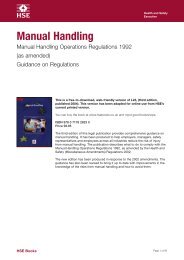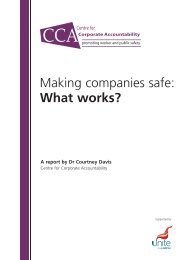Sustainable Transport and the Environment Guide - Unite the Union
Sustainable Transport and the Environment Guide - Unite the Union
Sustainable Transport and the Environment Guide - Unite the Union
You also want an ePaper? Increase the reach of your titles
YUMPU automatically turns print PDFs into web optimized ePapers that Google loves.
sound way to transport large volumes of goods across <strong>the</strong> world. Ninety percent of <strong>the</strong><br />
world’s manufactured goods <strong>and</strong> products travel by container ships <strong>and</strong> which has<br />
doubled in 25 years, but when this fact is considered, <strong>the</strong> relative impact upon <strong>the</strong><br />
environment is low in comparison to o<strong>the</strong>r modes of transport.<br />
For example, for every kilometre that a container ship carries a ton of cargo, it is far<br />
more energy efficient <strong>and</strong> emits much less in <strong>the</strong> way of harmful CO 2 emissions than<br />
any o<strong>the</strong>r type of freight transport, including airplanes, trucks <strong>and</strong> trains. It is<br />
estimated that on average a container ship emits around 40 times less CO 2 than a large<br />
freight aircraft <strong>and</strong> over three times less than a heavy truck. Container shipping is also<br />
estimated to be two <strong>and</strong> a half times more energy efficient than rail <strong>and</strong> 7 times more<br />
so than road.<br />
Even so, <strong>the</strong> industry recognises it cannot rest on its laurels. It is by definition a large<br />
industry <strong>and</strong> of course it does have an impact on <strong>the</strong> world around it. Container<br />
shipping companies are <strong>the</strong>refore working hard, alongside environmental agencies<br />
<strong>and</strong> governments, to minimise all impacts upon <strong>the</strong> environment.<br />
For example, all member lines of CSIS work with, or are full members of, <strong>the</strong> Clean<br />
Cargo Working Group <strong>and</strong> <strong>the</strong> World Shipping Council. The Clean Cargo Working<br />
Group, set up by Business for Social Responsibility, develops voluntary guidelines<br />
<strong>and</strong> metrics aimed at improving freight transport’s performance in environmental<br />
sustainability. By taking a cooperative, pan-industry approach, <strong>the</strong> group helps to<br />
promote environmental stewardship <strong>and</strong> sustainability in a competitive market.<br />
Working with legislators, appropriate government agencies <strong>and</strong> international<br />
organisations, <strong>the</strong> World Shipping Council focuses specifically on <strong>the</strong> areas of vessel<br />
air emissions, ballast water management, <strong>and</strong> <strong>the</strong> protection of North Atlantic Right<br />
Whales <strong>and</strong> coral reefs.<br />
As well as industry regulations <strong>and</strong> voluntary codes of conduct, <strong>the</strong>re are a great many<br />
environmentally-focused design features specifically built into containers <strong>and</strong> <strong>the</strong><br />
ships that carry <strong>the</strong>m. For example:<br />
<br />
<br />
<br />
<br />
<br />
<br />
<br />
It is now possible to recycle 98% of most container ships<br />
Containers are made of steel <strong>and</strong> are 100% recyclable<br />
If <strong>the</strong>y are not recycled to make new steel products <strong>the</strong>y often become ‘static’<br />
containers which can have charitable uses, such as schools in developing<br />
countries, or use as storage<br />
Many container shipping lines take steps to ensure that <strong>the</strong>ir ships travel at <strong>the</strong><br />
optimum speed for efficient fuel consumption<br />
Developments in hull <strong>and</strong> propeller design continue to improve fuel<br />
efficiency <strong>and</strong> reduce emissions – in fact a container ship now typically emits<br />
about a quarter of <strong>the</strong> CO 2 it did in <strong>the</strong> 1970s as well as carrying up to ten<br />
times as many containers<br />
Use of lower sulphur fuels is increasing <strong>and</strong> maximum sulphur content<br />
allowed in marine heavy fuel is now limited to 4.5 per cent, or as low as 1.5<br />
per cent in some areas<br />
All fuel is cleaned by filters <strong>and</strong> purifiers on board before use to help produce<br />
cleaner emissions<br />
61
















